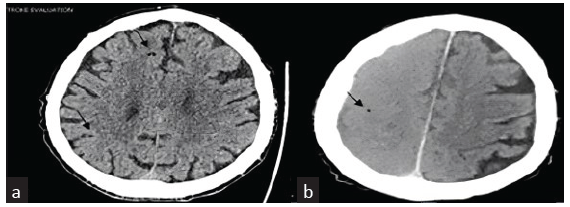Translate this page into:
A Bubbly Catastrophe: Air Embolism Presenting as Ischemic Stroke in a Patient on Hemodialysis
Corresponding author: Kalathil K Sureshkumar, Division of Nephrology and Hypertension, Medicine Institute, Allegheny General Hospital, Pittsburgh, PA, United States. E-mail: kalathil.sureshkumar@ahn.org
-
Received: ,
Accepted: ,
How to cite this article: Sureshkumar KK, Algayoum RA, Nashar K. A Bubbly Catastrophe: Air Embolism Presenting as Ischemic Stroke in a Patient on Hemodialysis. Indian J Nephrol. doi: 10.25259/IJN_23_2025
Dear Editor,
Air embolism is a rare but catastrophic situation. In humans, 100–300 mL of air entering the circulation and 2 mL in cerebral arteries can be fatal.1 We present a patient on hemodialysis (HD) with ischemic stroke and cerebral edema due to air embolism.
A 76-year-old male on maintenance HD through a tunneled catheter presented for evaluation of stroke symptoms. The patient developed right gaze preference, left hemiparesis, and dysarthria at his dialysis center after rinse back admission. A head and neck computed tomography (CT) angiogram with perfusion imaging revealed no acute intracranial abnormalities or infarcts. The patient developed worsening lethargy and weakness the next day. A repeat CT head revealed cerebral edema involving the right middle cerebral and anterior communication artery territories along with a small focus of air in the right vertex sulcus, which in retrospect was also present in the initial CT scan, consistent with air embolism [Figure 1]. Echocardiogram revealed no patent foramen ovale. Venous air entering arterial circulation through pulmonary capillaries or retrograde ascension to the cerebral venous system were considered as possible causes. Dialysis catheter inspection revealed no breach of structural integrity. The patient underwent emergent hyperbaric oxygen (HBO) therapy. Following three HBO sessions, symptoms improved, and the patient was discharged to a rehabilitation facility.

- (a) Initial CT imaging of the head showing the air embolism in retrospect (black arrows). (b) CT imaging of the head the following day showing cerebral edema on the right side and the air embolism more prominently (black arrow). CT: Computed tomography.
Despite the technological safeguards in new HD machines, air embolism can occur, mostly due to human error.2 Our case highlights the importance of implementing preventative measures, including adequate staff training, arterial luer lock tightening, adequate priming of the circuit, and maintenance of high blood levels in the venous air catcher.3 Vigilance is required for early diagnosis.4 Prompt HBO therapy is beneficial for patients with end-organ damage.5 Systemic hyperoxia from HBO reduces mechanical obstruction by reducing the air bubble size through displacement of nitrogen and improves tissue oxygenation.
Acknowledgement
The manuscript was presented in part as a poster at ASN Kidney Week 2022, Orlando, FL.
Conflicts of interest
There are no conflicts of interest.
References
- Adverse technical events in home hemodialysis. Am J Kidney Dis. 2015;65:116-21.
- [CrossRef] [PubMed] [Google Scholar]
- Diagnosis, treatment, and prevention of hemodialysis emergencies. Clin J Am Soc Nephrol. 2017;12:357-69.
- [CrossRef] [PubMed] [PubMed Central] [Google Scholar]
- Cerebral gas embolism associated with central venous catheter: Systematic review. J Neurol Sci. 2016;362:160-4.
- [CrossRef] [PubMed] [Google Scholar]






